Olga Mykhoparkina
Founder, CEO

Olga Mykhoparkina
Jul 11, 2025These days, a lot of people aren’t Googling for answers, they’re asking LLMs like ChatGPT, and getting instant, summarized advice right in the chat.
That means your content doesn’t always have to rank #1 in Google anymore to get seen. If an LLM picks it up and uses it in an answer you get visibility anyway. Sometimes even more than you would from a traditional blog click.
But LLMs aren’t quoting just anything. They pull content that’s clear, genuinely useful, easy to summarize, and structured for AI-first indexing. If your content checks those boxes, you’re way more likely to get cited, mentioned, and discovered by new customers.
In this post, I’ll walk you through 10 content formats that LLMs actually like and how to use them to get your brand in ChatGPT answers. Let’s get into it.
Not all content is LLM-friendly but some formats consistently show up in AI answers. Here are a few you should definitely be using on your SaaS site if you want more visibility without fighting for the top spot in Google.
LLMs prefer fresh data. If you’ve got unique stats, benchmarks, or survey results, you’re sitting on a goldmine. If you’ve got access to your industry usage data, customer trends, or can run a quick survey, share it! Publish your findings as a blog post, a report, or even a simple chart. This kind of content gets picked up because it’s both useful and hard to find anywhere else.

Why LLMs pick it up: AI looks for facts that stand out. If your site is the source of a stat or trend, that makes you quote-worthy.
How you can do it:
You don’t need a full-blown research report. Even a few solid stats in a blog post can get picked up.
LLMs are surprisingly good at spotting fluff – and they’ll skip right over your generic “thought leadership” if it sounds like everyone else. LLMs are looking for expert takes that are either backed by real experience or offer a contrarian (but logical) viewpoint. Plus, memorable opinions make your brand stick in people’s minds.
Why it works: LLMs prefer expert voices and citing unique perspectives, especially when they’re backed by real experience or data.
How to do it:

Example of an article by Tekpon with expert insights
Read also: From Blog Posts to Answers: Repurposing for AI Assistants
LLMs prefer structure. Numbered steps, short sentences, bullet points, and clear headings make your content easy to read and easy for AI to summarize. Whether it’s onboarding, troubleshooting, or a process breakdown, actionable guides are exactly what users (and LLMs) want when they’re trying to solve a problem. A well structured format ensures the information can be easily parsed by top models and adapted for various tasks.
For example: This is how our client, Fuel Finance, restructured their information by adding tables, FAQs, and other forms of content design in their blog. As a result, they got featured in ChatGPT AI answers for the keyword “AI forecasting tools.” The second column of their redesigned table provided actual content that was fine tuned for clarity, while the first offered plain text explanations that helped AI understand content in the right context.
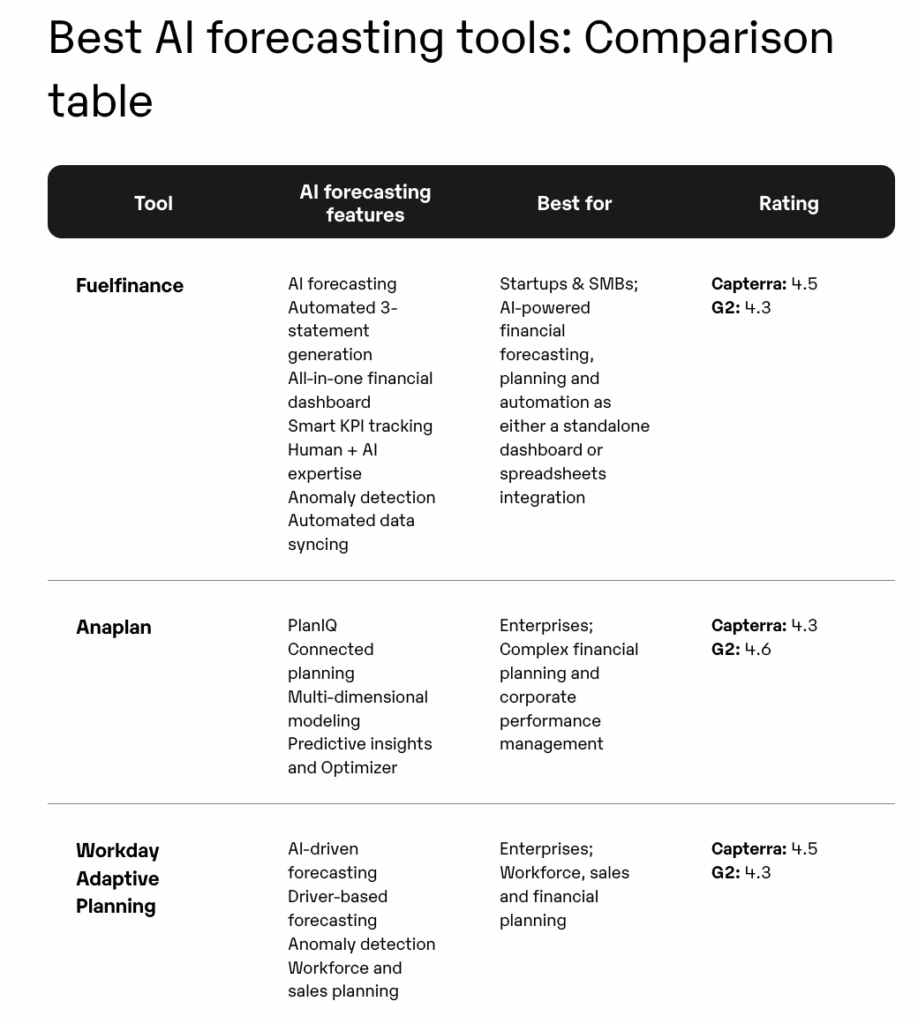

LLMs are trying to help people solve problems and answer questions. Step-by-step guides, when well structured and fine tuned, give them something useful to pull from. Because AI is trained on next word prediction, content with consistent format and clear context has a higher chance of being cited.
Keep it skimmable, use subheadings, and avoid info dumps. The cleaner the format, the more likely it’ll show up in an AI-generated answer. For SaaS and tech companies, investing in content design that is easily parsed and paired with other forms of media will help AI systems understand content.
Related: Schema & Structured Data for LLM Visibility: What Actually Helps?
People love asking LLMs to compare tools, features, and approaches before making a decision – “X vs Y,” “Is A better than B,” “What’s the difference between X and Z.” If you’ve got clear, side-by-side breakdowns, you’re already ahead. But if your post is too salesy or biased, LLMs will skip over you. Focus more on clarity and less on hype.

Example of a comparison article from upbase.io
Why it works: LLMs prefer structured comparisons for users deciding between tools, features, or strategies. It’s a go-to format for answering buyer questions.
How to do it:
Being real builds trust (with readers and machines).
You might be interested in: Structuring Web Pages for AI-First Indexing
You don’t need a separate FAQ page. Just work questions into your blog posts, product pages, or help docs, and answer them clearly. LLMs are trained to spot and answer questions, so the more your content mirrors how people actually ask, the better your chances of being featured in AI answers.

Example: Our client, Bettermode, added user questions into the blog content naturally.
Why it works: Direct, question-based content mirrors how people talk to LLMs. That makes it super easy for AI to pull your answers.
How to do it:
It’s a simple format, but it works really well for LLM visibility.
Learn more: How to get your SaaS brand quoted by ChatGPT (and other AI Tools)
LLMs prefer to cite real scenarios because it adds credibility to their answers. Even simple before-and-after examples can work wonders, as long as they’re clear, focused, and actually prove a point. Case studies give your content that real-world weight most blogs don’t have.
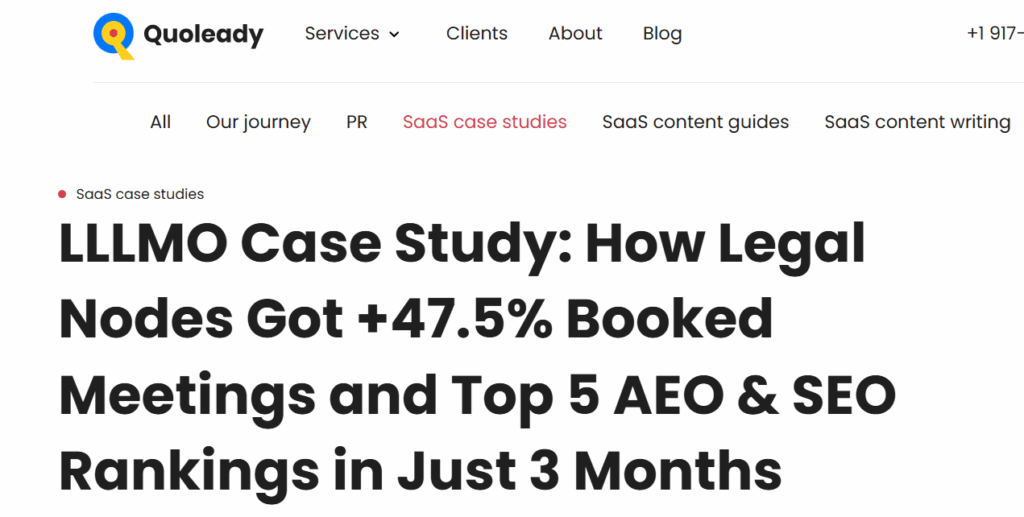
Example: Quoleady’s latest LLMO case study about getting their client, Legal Nodes, a 47.5% increase in meetings with top 5 AEO ranking within 3 months.
Why it works: Real-life examples build credibility and help users picture your product in action. LLMs use them to support broader points.
How to do it:
Just keep it concise. There’s no need to write a 2,000-word case study to understand how your product helped.
Don’t just rank on search—get found by AI assistants too. Work with Quoleady
If there’s one thing both readers and LLMs appreciate, it’s content that’s easy to skim. Lists, tables, and TL;DRs make your posts more digestible and easier to quote. Summaries or recap boxes at the top or bottom of your posts give LLMs easy info to grab and cite. Lists and tables break down info so it’s quick to scan, compare, and share.

Example: A comparison table with all important information about AI marketing agencies.
Why it works: Easy to parse, easy to cite. Structured info like this gives LLMs clean chunks to pull from without needing to “guess” what’s important.
How to do it:
This kind of structure helps people and machines get what they need.
Tools like Lovable help you create structured blog pages that resemble landing pages – they are easier to read, skim and comprehend. Here’s one of the examples of the blog structure you can build with the help of Lovable that’s structured, skimmable and easy to comprehend and pull information from:

See also: SEO vs GEO: Why Your Content Might Be Invisible in AI Search (And How to Fix It)
Checklists and cheat sheets are easy to skim for LLMs. You can easily break down detailed topics. They’re practical, actionable, and get easily featured into an AI-generated answer.
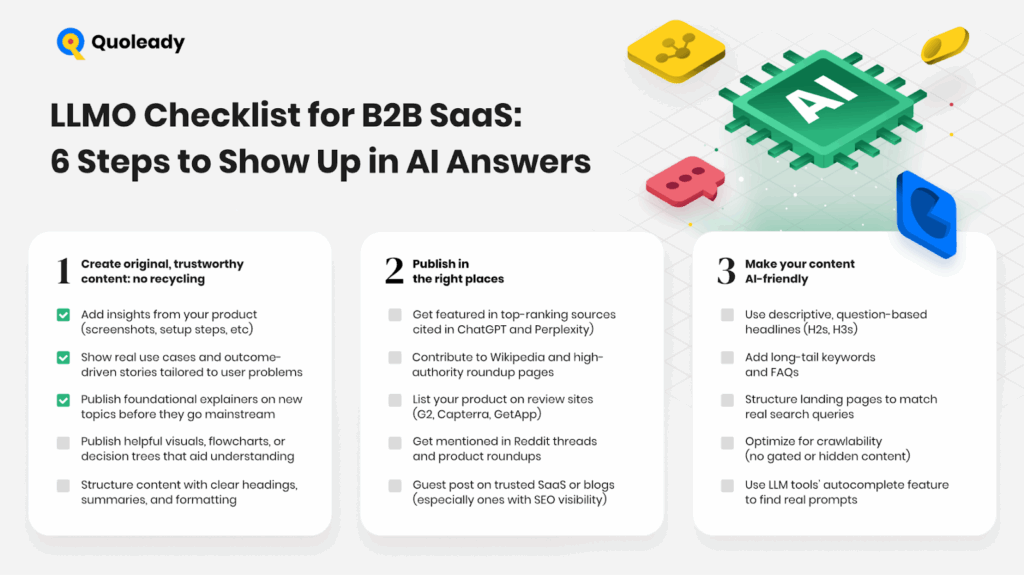
Why it works: LLMs prefer short, actionable formats. Checklists are easy to understand and easy to use, which makes them perfect to be in AI responses.
How to do it:
Bonus: checklists are also great lead magnets if you want to double up on value.
Producing great content is not enough, you need to format it properly. Schema markup and structured data help both LLMs and search engines “read” your content more easily.
Why it works: Making your content machine-readable with the help of schema and structured data for LLM visibility means a higher chance of getting picked up, cited, or featured in snippets.
How to do it:
You don’t need a dev team to get the basics in place.
Read also: Top 7 AI Marketing Agencies in 2025
Text isn’t the only thing LLMs are learning to understand. Models are getting better at picking up cues from images, audio, and video, especially when it’s paired with good metadata and transcripts.
Why it matters: Infographics, charts, and explainer videos can all show up in AI tools (and in Google’s AI Overviews). The richer your content, the more angles you can be cited from.
How to do it:
Even if AI doesn’t fully get your graphic today, you’re future-proofing your content for what’s coming next.
At Quoleady, we don’t just talk about LLM-friendly content — we build it. And our clients are already seeing the results show up in real AI-powered searches.
Here are a few quick wins from recent client projects:
We recently put ChatGPT to the test with the query “loyalty cards providers.”
The result: our clients Loopy Loyalty and PassKit showed up as the #1 and #2 answers.

This isn’t just luck, their content was clear, structured, and packed with unique insights, so LLMs trusted it enough to feature right at the top. That’s visibility you can’t buy with paid ads or even a #1 Google ranking.
Bettermode already had solid content, but we helped them appear in LLM answers.
We refined their structure with better headings, improved the flow, and rewrote section intros for more context.
The result: Bettermode appeared in Google AI Overview for over 2,000 keywords. For example:
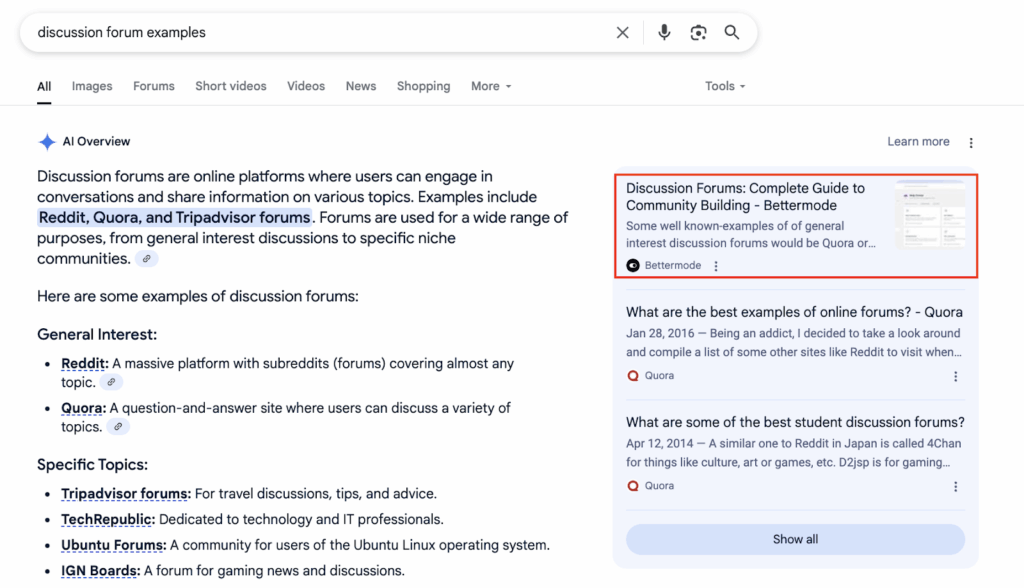
Their traffic went from a few hundreds to over 1k impressions in 6 months.
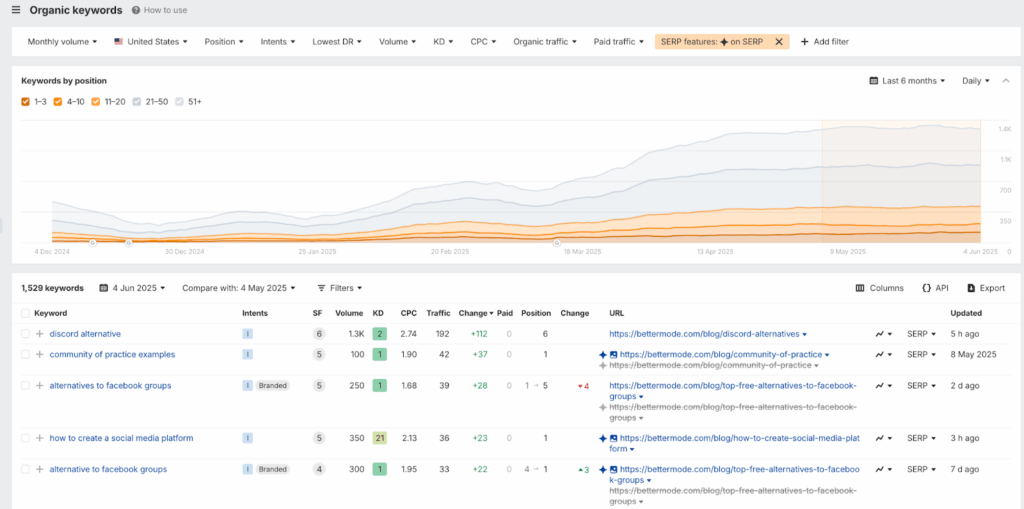
This proves that even small tweaks like clearer headings and stronger context can make your content more attractive to Google’s generative AI.
FuelFinance wrote a genuinely useful article, then layered in smart formatting and schema markup to boost visibility.
They added FAQ schema, clear data tables, question-style subheadings, and broke complex ideas into bite-sized, skimmable sections.
The result: their post now ranks for “AI forecasting tools” in Google AI Overview and gets picked up by ChatGPT for the same keyword.
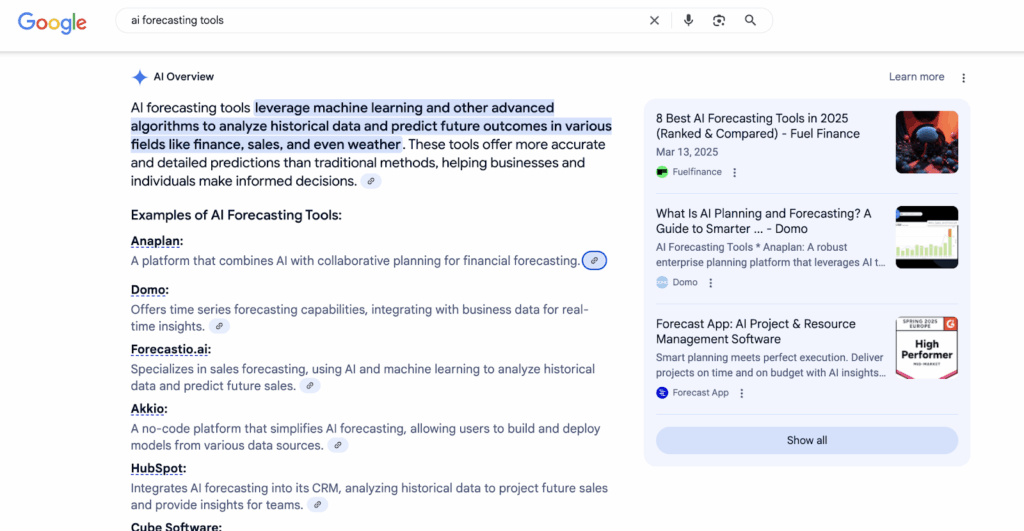
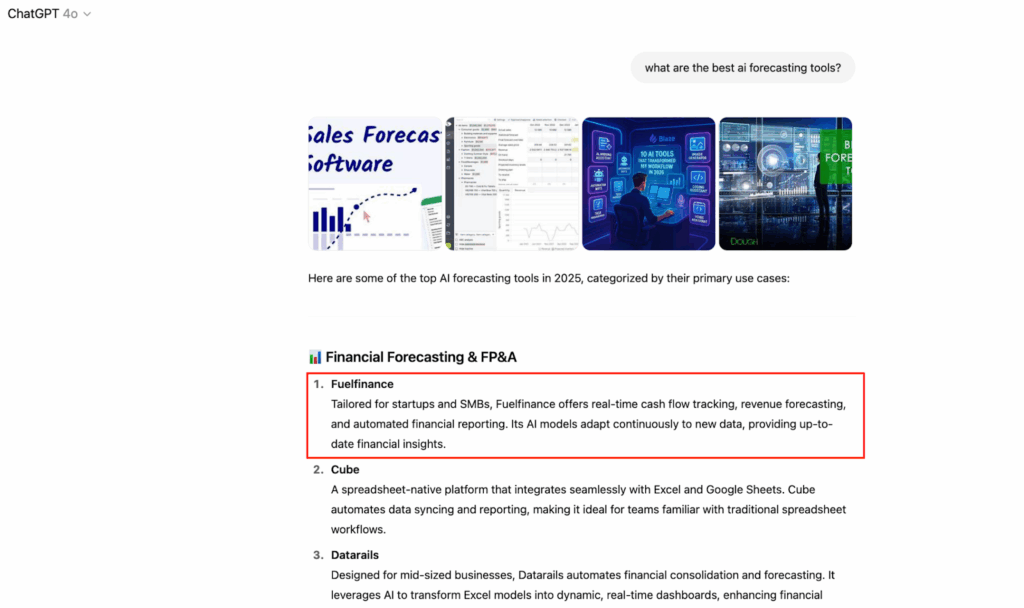
If your web content is clear, supported with structured data, and optimized with consistent file formats like XML, large language models are far more likely to feature it. These language models don’t just copy text — they analyze context, process natural language, and look for formats that can be parsed quickly even at inference time.
You don’t even have to rank #1 to show up in AI-generated answers. Structured data and clean LLM-content-format give language models a foundation for better understanding and quoting your material.
Action step: Pick 2–3 of the formats above and apply them to your next blog, landing page, or even short social media posts. It doesn’t have to be a complete content overhaul — small improvements to structured data, file formats like XML, and how you present context can make a huge difference.
And if you need help creating LLM-friendly content design for your SaaS site, that’s exactly what we do at Quoleady. Let’s make your expertise impossible for large language models to ignore.
Large language models (LLMs) look for content that’s clear, highly structured, and easy to quote. They favor helpful formats like step-by-step guides, FAQs, tables, or html markup. Both human readers and systems benefit when you structure information properly, using headings, lists, and consistent file formats. This improves LLM performance because the data can be easily parsed and turned into a relevant response.
No. Language models don’t just pull from the top result in search engines. Instead, they evaluate what’s most helpful, well-formatted, and contextually correct. You can get cited in an answer even if you’re not ranking first. A simple format with clear headings and concise points often performs better than verbose sections.
Write like you’re trying to be genuinely helpful. Use clear headings, short paragraphs, and formats that mirror file formats AI can parse, such as html tables or schemas. Think about both human readers and artificial intelligence: what’s easy for them to understand and reuse in an answer? Incorporating retrieval augmented generation practices and leveraging the right tools will improve LLM performance and make your response more reliable.
LLM-friendly content is content that’s easy for large language models (LLMs) to process and surface in AI search engines. It’s usually well structured, specific, and written in a way that mirrors how users ask queries. Using consistent file formats, schema markup, and thoughtful content design ensures that both language models and human readers get value. The point isn’t just rankings in search engines, but creating answers that are helpful in real context.
Work with Quoleady to make your SaaS brand visible in both search and AI results
Let us know what you are looking to accomplish.
We’ll give you a clear direction of how to get there.
All consultations are free 🔥
